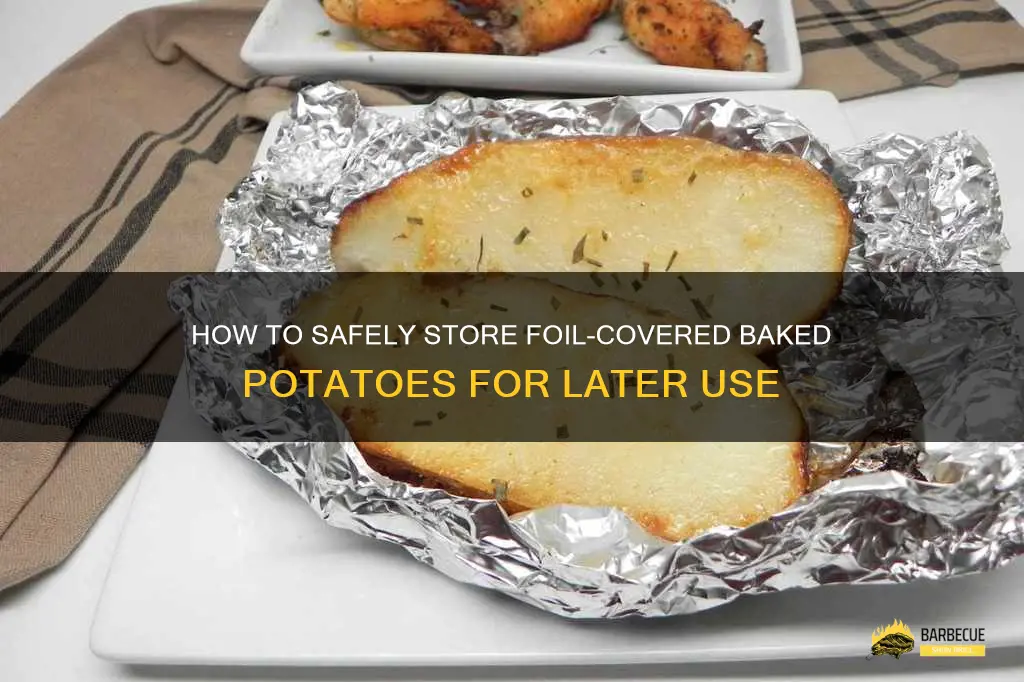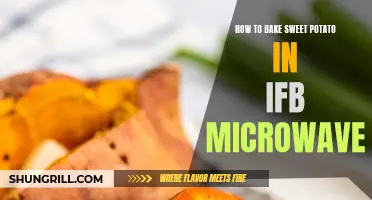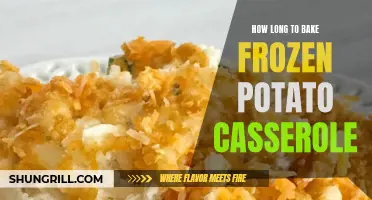
Are you wondering whether it's safe to put your foil-covered baked potatoes in the oven? Well, you've come to the right place! In this article, we will explore the ins and outs of cooking foil-covered baked potatoes and provide valuable insights to ensure a delicious and hassle-free potato experience. So, let's dive in and satisfy your potato cravings while keeping your kitchen safe and sound!
| Characteristics | Values |
|---|---|
| Type of Potatoes | Russet potatoes, Yukon gold potatoes, sweet potatoes |
| Size of Potatoes | Small, medium, large |
| Foil Covering | Yes, No |
| Seasoning | Salt, Pepper, Garlic powder, Paprika, Rosemary, Thyme, Olive oil, Butter |
| Cooking Method | Grilled, Baked, Microwaved |
| Cooking Temperature | 375°F - 425°F (190°C - 220°C) |
| Cooking Time | 45 minutes - 1 hour (depending on size and cooking method) |
| Texture | Soft and fluffy |
| Flavor | Savory, buttery, herby |
| Toppings | Sour cream, chives, shredded cheese, bacon bits, green onions |
| Serving Suggestions | Side dish for steak, grilled chicken, or roasted vegetables |
| Nutritional Value (per medium-sized potato) | Calories: 110, Carbohydrates: 26g, Fiber: 2g, Protein: 3g, Fat: 0g |
| Dietary Considerations | Gluten-free, vegetarian, vegan (if using plant-based toppings) |
| Precautions | Ensure foil is properly secured to prevent foil from coming into food |
What You'll Learn

Safety Concerns with Foil Covered Baked Potatoes
Baking potatoes in foil is a popular cooking method that helps retain moisture and creates a delicious, tender texture. However, it is important to be aware of the safety concerns that come with using foil when baking potatoes. While foil itself is not inherently dangerous, certain precautions should be taken to ensure safe and effective cooking.
- Potential for Botulism: One of the main concerns with cooking potatoes in foil is the risk of botulism. Botulism is caused by a toxin produced by the bacteria Clostridium botulinum, which can thrive in low-oxygen environments like sealed foil packets. When baking potatoes in foil, it is crucial to ensure that the foil is properly pierced or vented to allow steam to escape. This will prevent the growth of bacteria and eliminate the risk of botulism.
- Fire Hazard: Foil can also pose a fire hazard if not used correctly. When used in the oven or on a grill, the intense heat can cause the foil to ignite. To prevent this, always keep a close eye on the foil-covered potatoes while they are cooking and avoid using excessive heat. It is also recommended to place a baking sheet or foil-lined tray underneath the potatoes to catch any drips and prevent direct contact with the heating element.
- Uneven Cooking: Another concern with foil-covered baked potatoes is the potential for uneven cooking. Foil acts as a barrier that traps heat and moisture, which can result in inconsistent cooking. To ensure even cooking, it is best to prick the potatoes with a fork or knife before wrapping them in foil. This will allow steam to escape and heat to penetrate the potatoes from all sides, resulting in a properly cooked and evenly tenderized potato.
- Aluminum Leaching: There are also concerns about the potential for aluminum leaching into the potatoes when cooked in foil. While small amounts of aluminum may be transferred to the food, studies have shown that this is generally considered safe and within acceptable levels. However, if you are concerned about aluminum exposure, you can opt for using parchment paper or a baking bag instead of foil to bake your potatoes.
In conclusion, while baking potatoes in foil can be a convenient and delicious cooking method, it is important to be aware of the potential safety concerns involved. By ensuring proper ventilation, using caution to prevent fire hazards, and pricking the potatoes before wrapping them, you can safely enjoy foil-covered baked potatoes. If you have concerns about aluminum exposure, alternatives like parchment paper or baking bags can also be used. As with any cooking method, understanding and following safety guidelines will help ensure a safe and enjoyable cooking experience.
Uncover the Powerful Benefits of Including Baked Potatoes in Your Bulking Diet
You may want to see also

Alternative Methods for Cooking Foil Covered Baked Potatoes
If you're craving a deliciously crispy and tender baked potato, but don't want to use the traditional method of baking it in the oven, there are alternative methods available. One popular method is to use a barbecue grill, while another option is to use a slow cooker. Both of these methods will give you a perfectly cooked potato with a crispy skin, all without the need for an oven.
To cook foil-covered baked potatoes on a grill, start by heating the grill to medium-high heat. Scrub the potatoes clean and then poke them with a fork several times. This will allow steam to escape while they cook. Brush the potatoes with olive oil and sprinkle with salt and pepper, if desired. Wrap each potato tightly with aluminum foil, making sure to completely cover them. Place the potatoes on the grill and close the lid. Cook for about 45 minutes to an hour, or until the potatoes are tender when pierced with a fork. Carefully remove the foil and let the potatoes cool slightly before serving.
If you prefer to use a slow cooker, start by washing the potatoes and poking them with a fork. Brush each potato with olive oil and sprinkle with salt and pepper, if desired. Wrap each potato tightly with aluminum foil, making sure to completely cover them. Place the foil-wrapped potatoes in the slow cooker and cover with the lid. Cook on high for about 4 to 5 hours or on low for 7 to 8 hours, or until the potatoes are tender when pierced with a fork. Carefully remove the foil and let the potatoes cool slightly before serving.
Another alternative method for cooking foil-covered baked potatoes is to use a campfire. If you're camping or just want to enjoy a rustic meal, this method is perfect. Start by preparing a campfire and letting it burn down to hot coals. Scrub the potatoes clean and then poke them with a fork several times. Rub each potato with olive oil and sprinkle with salt and pepper, if desired. Wrap each potato tightly with aluminum foil, making sure to completely cover them. Place the foil-wrapped potatoes directly onto the hot coals, spacing them out so they're not touching. Cook for about 45 minutes to an hour, or until the potatoes are tender when pierced with a fork. Carefully remove the foil and let the potatoes cool slightly before serving.
No matter which alternative method you choose, cooking foil-covered baked potatoes can be a delicious and convenient way to enjoy this classic dish without an oven. So fire up the grill, plug in the slow cooker, or head out to the campfire and get ready to savor the taste of perfectly cooked foil-covered baked potatoes.
Cooking Instructions for Omaha Steak Twice Baked Potatoes
You may want to see also

The Impact of Foil on Baking Time and Texture of Potatoes
When it comes to preparing baked potatoes, many people wonder if they can put foil on them before placing them in the oven. The answer to this question is yes, you can definitely put foil on your baked potatoes. However, it's important to understand the impact that foil can have on the baking time and texture of the potatoes.
One of the main reasons why people choose to use foil when baking potatoes is to help retain moisture. When the potatoes are wrapped in foil, the heat is trapped inside, creating a steaming effect. This can result in potatoes that are moist and soft on the inside.
Another benefit of using foil is that it can help to speed up the baking time. The foil acts as a barrier, preventing the outer layer of the potatoes from browning too quickly. This allows the potatoes to cook evenly and thoroughly.
However, it's important to note that using foil can also have a downside. While it can speed up the cooking process, it can also prevent the potatoes from developing a crispy skin. If you prefer a crispy exterior on your baked potatoes, it's best to leave the foil off.
To achieve the best results when using foil on your baked potatoes, here's what you need to do:
- Preheat your oven to the desired temperature (usually around 400 degrees Fahrenheit).
- Wash the potatoes thoroughly and dry them with a paper towel.
- Pierce the potatoes with a fork several times to allow steam to escape during baking.
- Rub the potatoes with olive oil or melted butter and season with salt and pepper, if desired.
- Wrap each potato individually with a sheet of aluminum foil, making sure they are tightly sealed.
- Place the foil-wrapped potatoes directly on the oven rack or on a baking sheet.
- Bake the potatoes for approximately 45 minutes to 1 hour, depending on their size. To check for doneness, insert a fork or knife into the center of the potato - it should slide in easily.
- Once the potatoes are cooked, carefully remove them from the oven and let them cool for a few minutes.
- Carefully remove the foil from each potato, being cautious of the hot steam that may escape.
- Serve your delicious baked potatoes with your favorite toppings, such as sour cream, chives, cheese, or bacon.
In conclusion, using foil on your baked potatoes can be a great way to retain moisture and speed up the cooking process. However, it's important to note that it may prevent the potatoes from developing a crispy skin. By following the steps outlined above, you can achieve perfectly cooked foil-covered baked potatoes that are moist and flavorful.
How to Bake Sweet Potatoes in the Broiler: A Quick and Easy Guide
You may want to see also

Tips for Successfully Cooking Foil Covered Baked Potatoes
Cooking baked potatoes is a simple and delicious way to enjoy this versatile vegetable. Whether you are using russet, red, or sweet potatoes, baking them in foil can help retain moisture and create a tender and flavorful result. Here are some tips to help you successfully cook foil-covered baked potatoes:
- Choose the right potatoes: Russet potatoes are the best choice for baked potatoes as they have a starchy texture and a neutral flavor that pairs well with a variety of toppings. However, you can also use red or sweet potatoes if you prefer a different taste and texture.
- Wash and scrub the potatoes: Before baking, wash and scrub the potatoes thoroughly to remove any dirt or debris. Pat them dry with a clean towel.
- Preheat the oven: Preheating the oven is essential for even cooking. Set the oven to 400°F (200°C) and allow it to reach the desired temperature before baking the potatoes.
- Pierce the potatoes: Use a fork to pierce the potatoes in several places. This step ensures that steam can escape during cooking, preventing the potatoes from exploding.
- Coat the potatoes with oil and seasonings: To enhance the flavor and create a crispy skin, rub the potatoes with olive oil or melted butter. Sprinkle them with salt and any other seasonings you desire, such as garlic powder or paprika.
- Wrap the potatoes in foil: Individually wrap each potato in aluminum foil, making sure to seal them tightly to trap the steam inside. This method helps cook the potatoes evenly and keeps them moist.
- Place the potatoes on a baking sheet: Arrange the foil-wrapped potatoes on a baking sheet. This will catch any drippings and prevent them from making a mess in your oven.
- Bake the potatoes: Place the baking sheet with the potatoes in the preheated oven. Baking time can vary depending on the size and type of potatoes, but a general estimate is around 45 minutes to 1 hour.
- Check for doneness: To check if the potatoes are fully cooked, use a fork to pierce them through the foil. If the fork slides in easily and the potatoes feel soft, they are done. If they still feel firm, continue baking for a few more minutes.
- Allow the potatoes to rest: Once the potatoes are cooked, remove them from the oven and let them rest for about 5 minutes before serving. This allows the steam inside the foil to settle and ensures the potatoes are fully cooked and ready to be enjoyed.
- Serve and enjoy: Carefully unwrap the foil from the potatoes and transfer them to plates. Slice them open, and fluff the insides with a fork. Add your favorite toppings such as butter, sour cream, cheese, chives, or bacon bits, and enjoy!
Cooking foil-covered baked potatoes is a straightforward process that yields delicious results every time. By following these tips, you can create perfectly cooked, tender, and flavorful baked potatoes that make a great addition to any meal.
Preserving the Crunch: How to Save a Baked Potato for Later Enjoyment
You may want to see also
Frequently asked questions
Yes, you can put your foil covered baked potatoes in the microwave. However, make sure to remove any metal foil before microwaving as it can cause sparks and damage the microwave.
Yes, you can put your foil covered baked potatoes in the oven. The foil helps to trap heat and steam, resulting in a softer and more evenly cooked potato. Just be sure to remove the foil during the last few minutes of baking to allow the skin to crisp up.
Yes, you can put your foil covered baked potatoes in the fridge. Allow the potatoes to cool completely before wrapping them tightly in foil and placing them in the refrigerator. The foil will help to retain moisture and prevent the potatoes from drying out.







